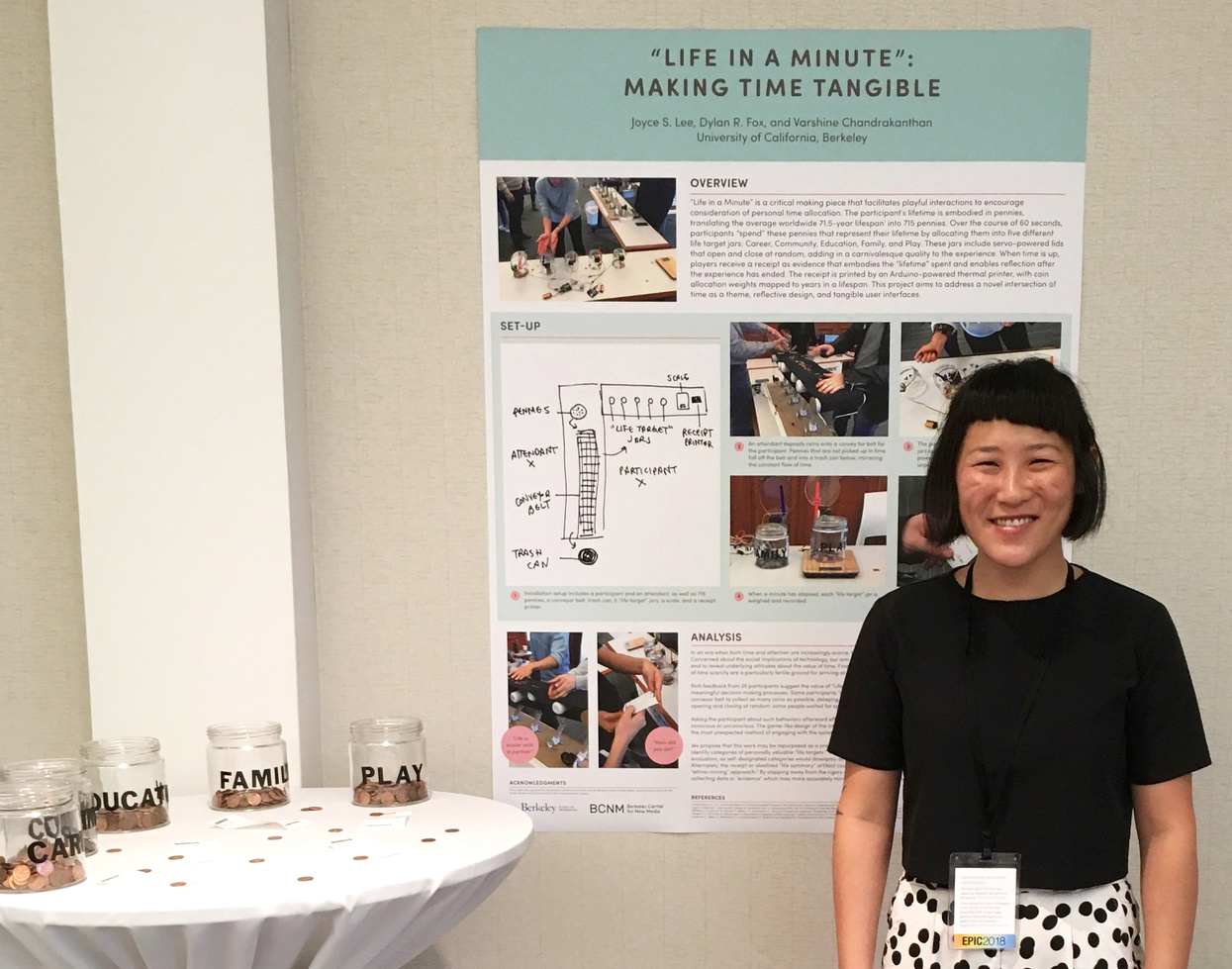Conference Grants: Joyce Lee at EPIC

Joyce Lee received a Fall 2018 BCNM Conference Grant to help cover their costs attending the AEthnographic Praxis in Industry Conference in Honolulu, Hawaii. Lee presented “Life in a Minute.” Read more about their experience in Gipson's own words below!
Ethnographic Praxis in Industry Conference (EPIC) took place this year in Honolulu, Hawai‘i from October 9-12, 2018. EPIC is a volunteer-run organization, and the conference was attended by an interdisciplinary and international mix of private-sector practitioners, independent consultants, scholars, as well as researchers from governments and NGOs. The event included presentations of papers, case studies, salons, and more – all on the annual theme of “evidence.”
As evidence comes in multiple forms – written, oral, visual, or three-dimensional – the conference also hosted a gallery to display examples of evidence, including design artifacts, data visualizations, photographic collages, installations, etc. In this gallery, I presented “Life in a Minute,” a project created during the BCNM course, Theory and Practice of Tangible User Interfaces, taught by Kimiko Ryokai and Noura Howell.
Making Time Tangible: “Life in a Minute”
Created with Dylan Fox and Varshine Chandrakanthan, “Life in a Minute” is a critical making piece that facilitates playful interactions to encourage people to reconsider their personal time allocation. The participant’s lifetime is embodied in pennies, translating the average worldwide 71.5 year lifespan (according to the UN) into 715 pennies. Over the course of 60 seconds, participants “spend” these pennies that represent their lifetime by allocating them into five different life target jars – Career, Community, Education, Family, and Play: these include servo-powered lids that open and close at random, adding in a carnivalesque quality to the experience.
When time is up, players receive a receipt as evidence that embodies the “lifetime” spent and enables reflection after the experience has ended. The receipt is printed by an Arduino-powered thermal printer, with coin allocation weights mapped to years in a lifespan. Addressing a novel intersection of time as a theme, reflective design, and tangible user interfaces, the project was well received and aligned with the concept of data physicalization, discussed in other conference presentations.
On AirSpace, Affordances, and Alternatives to Austerity Thinking
Many of the conference presentations were relevant to current coursework, though a few were of particular interest for own research interests. The first was by Tom Hoy (Stripe Partners), who presented his paper, “Doing Ethnography in AirSpace: The Promise and Danger of ‘Frictionless’ Global Research.” Introduced by Kyle Chayka, the concept of “AirSpace” refers to the aesthetic convergence that has resulted from the rise of technological platforms such as Airbnb and Yelp – why coffee shops around the world now employ bearded baristas and decorate their spaces with exposed brick, mid-century modern furniture, and succulents. Hoy expressed appreciation for AirSpace, as it makes remote cultures feel accessible and personally reduces friction for his own international research practice. However, he also cautioned that AirSpace is an easy shortcut that invites shallow forms of understanding; truly embracing site-specific cultures requires challenging homogeneity that may emerge from the adoption of certain technologies.
Another resonant presentation was by Sue Faulkner (Intel), called “Invisible Evidence: Our Disconnection with Broadband Connectivity.” Faulkner described the emergent, highly emotional need to be constantly connected, and how current internet routers fail spectacularly to meet our needs – either it works, or it does not. Based on her ethnographic research, Faulkner offered speculative affordances that might better serve this essential part of contemporary well being. One approach could mirror that of a thermostat, which would indicate signal strength in discrete numeric values; an alternative involved something like a shower handle to actually allow control of connectivity. Both propositions would be far more decipherable than a current router’s colored blinking lights, Faulkner argued, and are in the realm of necessary improvements to meet our new need to be connected.
The most memorable conference presentation, however, was a keynote by Virginia Eubanks (University at Albany, SUNY), author of Automating Inequality: How High-Tech Tools Profile, Police, and Punish the Poor. Eubanks discussed concepts from her latest book, including the American tradition of considering public services as moral thermometers rather than universal floors in public services. Furthermore, she discussed the long-standing tradition of “austerity thinking:” because social welfare systems assume austerity is required, they reproduce it and override empathy along the way. Beyond the social implications of technology for marginalized populations, Eubanks also explained that designing “neutral” technology only perpetuates the status quo. She emphasized the importance of “impacts, not intentions” and provided a call to action: to build a more just future with purpose, “brick by brick” and “byte by byte.”
Closing Thoughts
Attending EPIC 2018 offered a view into the various perspectives of practitioners grappling with the validity of big data as evidence – highlighting unintended consequences and offering alternative visions for the future. I found much of the discussion and design implications to be rich and well matched to the type of work I’d like to pursue in the future. Many thanks to the BCNM for their support!
